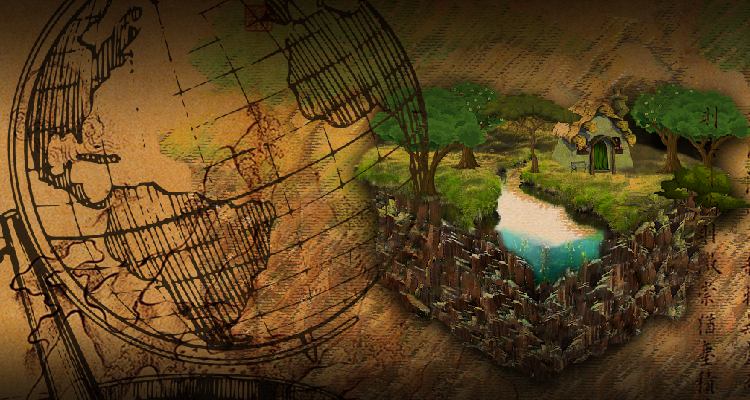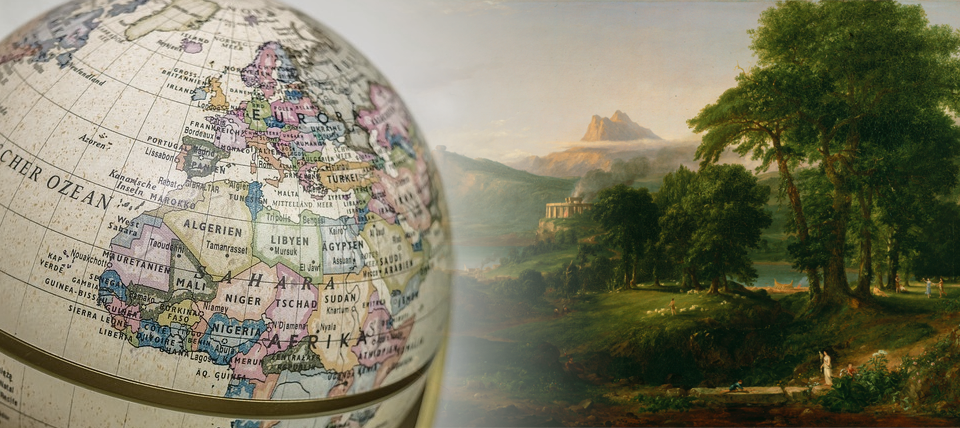World building is the creation of new worlds and new universes. Everything from geography to cosmology, from politics to climate, world building is inventing a unique and living world for players to participate in. Here are 5 tips I want to pass on from my many years of world building for RPGs.
Think Big, but Start Small
When designing a campaign for your players you’ll often find tips about starting small. This is sage advice because it’s easy to get lost in the fine details of creating an entire world. Things like languages, racial tensions, deities, geography, history, and factions can take months and even years to fully flesh out, and without them you run the risk of your world lacking consistency.
The key is to think large-scale while applying your efforts in small manageable portions. The best way I’ve found to do this is to take that epic world map you drew and focus on one section in great detail. Give specifics for each town, points of interest, regional conflicts and recent history.
Which deities have shrines and temples there and why? Which factions are interested in that particular area and what are they up to? What recent events have caused the locals to hire adventurers and how does it tie into the historic lore of your larger world?
The strategy is to take the best ideas for your world and format them into actionable locations, quests, and characters in a playable and interactive world area.
Balance Between Sandbox and Story
Choosing to make a game more focused on sandbox or on story requires knowing your players and their preferences well. I have found that most players enjoy playing in a sandbox focused world, which allows their characters to run around freely without a predetermined path. This requires having either a thorough design of your world area or possessing above average improv skills.
In the immediate world area (any geographical locations the characters could reach in this play session) there should be at least two potential events (quests or missions) for characters to participate in if they decide to. Each event should have multiple hooks i.e. characters or conflicts that pull the players into participating in that event.
A character’s time is valuable and if an event is worth their time it should affect more than a single NPC, which means you should have more than one quest-giver for the same event.
In addition to events, there should also be other points of interest like strange ruins, derelict crafts, weird lights in the distance, or new settlements on the frontier. Remember, all of these points should have some relation to your broader world building ideas like ancient history, current events, or lore. Otherwise they are just filler.
Both events and points of interest should have some resemblance of a resolution as well as a new hook or lead for players to pursue if they want to. This will make game play in your world both satisfying and progressive.
For a story focused game, the plot will drive its design. Story driven games tend to be more railroaded with pre-written dialogue and outcomes. As the world builder, your challenge is to get the players interested and involved in the story you’ve created.
Still, remember to apply the first rule: Think Big, Work Small. You can totally write an epic scale adventure for characters to participate in, but it shouldn’t start out that way. Start with a mystery or intriguing hook; perhaps the sudden appearance of a massive impossibly floating object in the distance. Or open with the assassination of the local Lord in which the players take the role of the Lord’s outmatched guards in a vignette scene.
As the story progresses it becomes more elaborate and involves more powerful creatures and NPCs; eventually leading into the epic scale story you wrote for your world.
Ideas are Cheap, Execution is Valuable
Good ideas do not an interesting world make. A well-designed world with basic ideas is much more valuable than a poorly-designed world with good ideas. The challenge is in taking the ideas you have and developing them into consistent, logical consequences.
If magic can create food in this world, farming would be replaced by an industry of spell casters and magical component gatherers. This would mean that settlements would be based on access to magical items and resources instead of soil fertility. Army supply lines would be replaced by food-creators, allowing mobile armies of soldiers unseen in our own world’s history.
If dragons hoarded massive collections of riches and treasures, they could artificially manipulate the local economies at will. They could flood the markets with cheap gold items to inflate the Lord’s coin value, or hire rogues and spies to remove riches from the local towns, driving prices of goods and services to plummet. They could wreak havoc without ever using their breath weapon.
If deities and demons rule from alternate dimensions, they would be akin to CEOs with their cohorts organized like corporations. Even demon lords and celestial angels need resources to achieve their goals, and that means creating ways to generate revenue. Curing diseases and removing curses at local temples is a great start, but what about mass-potion production or armor manufacturing? Unsavory deities could traffic weapons, drugs, or even people.
The important point here is that it isn’t interesting enough just to have magic, dragons, or gods. What is interesting is how these ideas are implemented in your world. Don’t worry about diving too hard into this, because I guarantee no matter how deep you go, a player or group of players will always find some fallacy in the details. You only need to develop your ideas enough to make the world yours and unique.
Integrate the World with the Game
I’ve been building my current world for well over a year now, and it wasn’t until last month that I realized it simply was not fit for the Dungeons & Dragons system. This is a hard-learned lesson for me, because I realized the reason I’ve been struggling recently is because I’ve been trying to paint D&D with my world rather than build my world as a game.
Maybe the best place to start world building for an RPG is the RPG itself. Look at the mechanics, the classes, skills, magic system, etc. and start imagining how those mechanics would look in your world.
What does a wizard look like? An older person whose life of studying magic has left them physically weak? Or maybe they are athletic collectors of lore who dawn armored robes and helmets to venture out into dangerous places hunting for ancient artifacts.
This doesn’t mean you have to conform your world to fit nicely into a game system, but you should use the game system as the foundation for the themes and feel of your world. If the game isn’t a good platform for your ideas, maybe you should look for a new game system, like I did.
Always be Writing, Playing, or Reading
This is straightforward – world building can be a lot of work, but it doesn’t always mean hammering away at a notebook, world map, or computer for hours at a time and months on end. Play some games and read some books to activate your brain and keep your ideas fresh.
What sort of tips have you discovered in your world building? Let us know in the comments.





